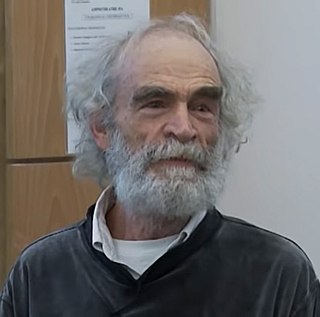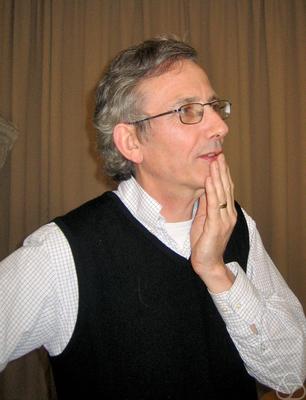
In mathematics, a metric space is a set together with a notion of distance between its elements, usually called points. The distance is measured by a function called a metric or distance function. Metric spaces are the most general setting for studying many of the concepts of mathematical analysis and geometry.

In algebra, ring theory is the study of rings—algebraic structures in which addition and multiplication are defined and have similar properties to those operations defined for the integers. Ring theory studies the structure of rings, their representations, or, in different language, modules, special classes of rings, as well as an array of properties that proved to be of interest both within the theory itself and for its applications, such as homological properties and polynomial identities.
Noncommutative geometry (NCG) is a branch of mathematics concerned with a geometric approach to noncommutative algebras, and with the construction of spaces that are locally presented by noncommutative algebras of functions. A noncommutative algebra is an associative algebra in which the multiplication is not commutative, that is, for which does not always equal ; or more generally an algebraic structure in which one of the principal binary operations is not commutative; one also allows additional structures, e.g. topology or norm, to be possibly carried by the noncommutative algebra of functions.
In mathematics, Gromov–Hausdorff convergence, named after Mikhail Gromov and Felix Hausdorff, is a notion for convergence of metric spaces which is a generalization of Hausdorff convergence.

Mikhael Leonidovich Gromov is a Russian-French mathematician known for his work in geometry, analysis and group theory. He is a permanent member of IHÉS in France and a professor of mathematics at New York University.

Geometric group theory is an area in mathematics devoted to the study of finitely generated groups via exploring the connections between algebraic properties of such groups and topological and geometric properties of spaces on which these groups act.

Sir Simon Kirwan Donaldson is an English mathematician known for his work on the topology of smooth (differentiable) four-dimensional manifolds, Donaldson–Thomas theory, and his contributions to Kähler geometry. He is currently a permanent member of the Simons Center for Geometry and Physics at Stony Brook University in New York, and a Professor in Pure Mathematics at Imperial College London.
In mathematics, the geometric topology is a topology one can put on the set H of hyperbolic 3-manifolds of finite volume.
In the mathematical field of metric geometry, Mikhael Gromov proved a fundamental compactness theorem for sequences of metric spaces. In the special case of Riemannian manifolds, the key assumption of his compactness theorem is automatically satisfied under an assumption on Ricci curvature. These theorems have been widely used in the fields of geometric group theory and Riemannian geometry.
Hilbert C*-modules are mathematical objects that generalise the notion of a Hilbert space, in that they endow a linear space with an "inner product" that takes values in a C*-algebra. Hilbert C*-modules were first introduced in the work of Irving Kaplansky in 1953, which developed the theory for commutative, unital algebras. In the 1970s the theory was extended to non-commutative C*-algebras independently by William Lindall Paschke and Marc Rieffel, the latter in a paper that used Hilbert C*-modules to construct a theory of induced representations of C*-algebras. Hilbert C*-modules are crucial to Kasparov's formulation of KK-theory, and provide the right framework to extend the notion of Morita equivalence to C*-algebras. They can be viewed as the generalization of vector bundles to noncommutative C*-algebras and as such play an important role in noncommutative geometry, notably in C*-algebraic quantum group theory, and groupoid C*-algebras.
The Geometry Festival is an annual mathematics conference held in the United States.
In noncommutative geometry and related branches of mathematics and mathematical physics, a spectral triple is a set of data which encodes a geometric phenomenon in an analytic way. The definition typically involves a Hilbert space, an algebra of operators on it and an unbounded self-adjoint operator, endowed with supplemental structures. It was conceived by Alain Connes who was motivated by the Atiyah-Singer index theorem and sought its extension to 'noncommutative' spaces. Some authors refer to this notion as unbounded K-cycles or as unbounded Fredholm modules.
In mathematical physics, the concept of quantum spacetime is a generalization of the usual concept of spacetime in which some variables that ordinarily commute are assumed not to commute and form a different Lie algebra. The choice of that algebra still varies from theory to theory. As a result of this change some variables that are usually continuous may become discrete. Often only such discrete variables are called "quantized"; usage varies.

Noncommutative algebraic geometry is a branch of mathematics, and more specifically a direction in noncommutative geometry, that studies the geometric properties of formal duals of non-commutative algebraic objects such as rings as well as geometric objects derived from them.

Richard Vincent Kadison was an American mathematician known for his contributions to the study of operator algebras.

Nikita Alexandrovich Nekrasov is a mathematical and theoretical physicist at the Simons Center for Geometry and Physics and C.N.Yang Institute for Theoretical Physics at Stony Brook University in New York, and a Professor of the Russian Academy of Sciences.
In mathematics, and more specifically in the theory of C*-algebras, the noncommutative toriAθ, also known as irrational rotation algebras for irrational values of θ, form a family of noncommutative C*-algebras which generalize the algebra of continuous functions on the 2-torus. Many topological and geometric properties of the classical 2-torus have algebraic analogues for the noncommutative tori, and as such they are fundamental examples of a noncommutative space in the sense of Alain Connes.

Jonathan Micah Rosenberg is an American mathematician, working in algebraic topology, operator algebras, K-theory and representation theory, with applications to string theory in physics.
Henri Moscovici is a Romanian-American mathematician, specializing in non-commutative geometry and global analysis.
In mathematics, nonabelian algebraic topology studies an aspect of algebraic topology that involves higher-dimensional algebras.








